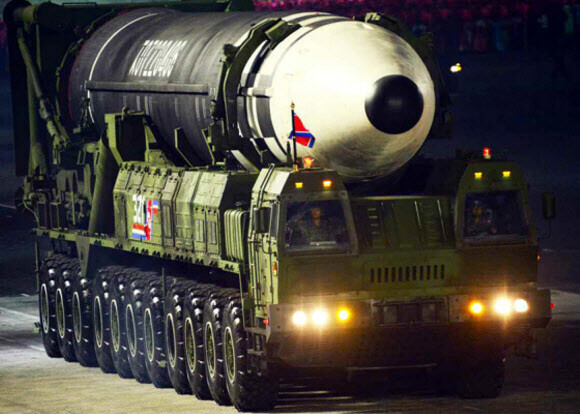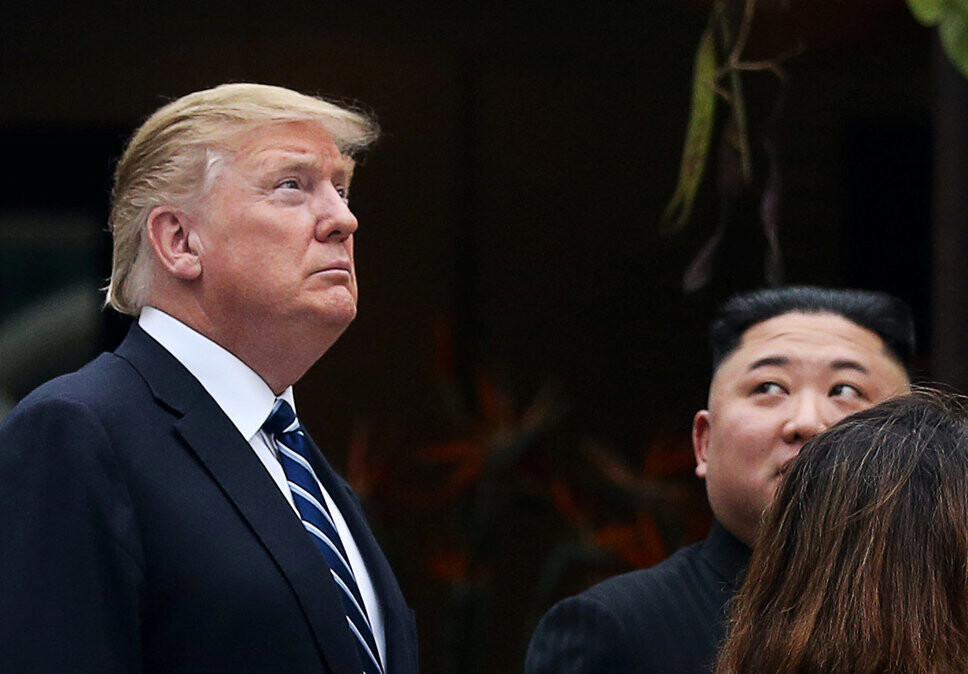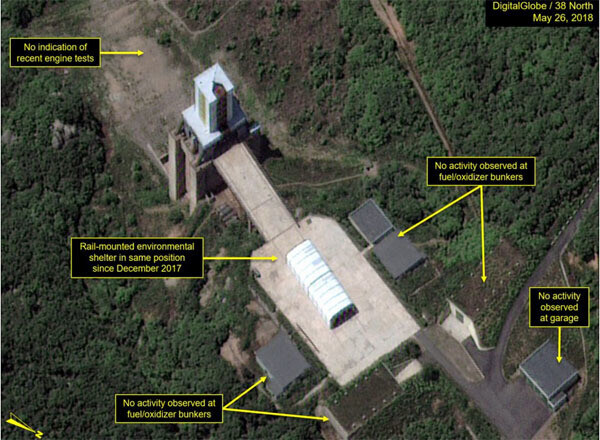hankyoreh
Links to other country sites 다른 나라 사이트 링크
[News analysis] How was N. Korea able to build its monstrous new ICBM?

“Kim Jong-sik is currently guiding a huge strategic nuclear weapon past Kim Il-sung Square.”
The most striking feature of the military parade that began in Kim Il-sung Square in Pyongyang at 12 am on Oct. 10, marking the 75th anniversary of the establishment of the Workers’ Party of Korea (WPK), was the massive intercontinental ballistic missile (ICBM) that emerged at the very end of the parade. This missile, which North Korea described as a “huge strategic nuclear weapon,” managed to attract the attention of countries close to the Korean Peninsula for several reasons.
Looking back, North Korea had already shown that it had developed an ICBM capable of striking the continental US with its successful launch of the Hwasong-15 on Nov. 29, 2017. Now that the North has unveiled an even larger ballistic missile, it’s reasonable to assume the new missile has qualities that set it apart from the earlier Hwasong-15.
To begin with, the new missile is much bigger than the Hwasong-15. It was hard to miss the 11-axle launcher vehicle, dwarfing the 9-axle vehicle that carried the Hwasong-15. Based on video footage released on Oct. 10, the new missile appears to be about 25-26m long and 2.5-2.9m in diameter.
The greater size leaves no doubt that the new missile either has a greater range or carries a heavier payload than its predecessor. But considering that the Hwasong-15 is already capable of striking the American cities of New York and Washington, range itself seems unimportant unless North Korea wants to bring South America into range.
That has led experts to posit that the missile is equipped with MIRV technology, referring to a multiple independently targetable reentry vehicle. That would mean that the missile could carry several warheads. South Korean newspaper the Chosun Ilbo even speculated on Oct. 12 that “the missile could likely carry two or three warheads that could launch simultaneous strikes on Washington and New York.”
“Right now, experts are looking at the possibility of multiple warheads. I think that possibility needs to be closely examined,” former Unification Minister Kim Yeon-chul said on Oct. 12. Kim made the comments during an MBC program called “A Closer Look with Kim Jong-bae.” But since North Korea has yet to test launch the missile, it will probably take some time before we can confirm its exact capabilities.

That naturally leads to the next question. When did North Korea build this huge ballistic missile? The answer can’t be known with certainty since ICBM development is strategic information that all countries handle with the utmost secrecy. Even so, we do have some hints, thanks to North Korea’s practice of letting the outside world know its intentions by publicizing the process of its strategic weapon development.
An essential part of building a big ICBM is testing the engine, the key component of the weapon. On Dec. 7 and Dec. 13, 2019, North Korea announced that it had carried out two major tests at Tongchang Village.
That came after the North’s negotiations with the US basically broke down in Hanoi, on Feb. 28 of the same year, with the two sides unable to reach a deal. In April, North Korean leader Kim Jong-un had said he would wait until the end of the year for the US to make a sincere response, but the tests were held before that deadline.
Those tests were announced in two statements from the state-run Korean Central News Agency, printed verbatim below.
<<< FIRST STATEMENT BEGINS >>>
Statement of Spokesman for Academy of National Defense Science Issued
Pyongyang, December 8 (KCNA) -- A very important test took place at the Sohae Satellite Launching Ground on the afternoon of December 7, 2019.
The Academy of the National Defense Science of the DPRK made a report on the successful result of the test of great significance to the Central Committee of the Workers’ Party of Korea.
The results of the recent important test will have an important effect on changing the strategic position of the DPRK once again in the near future.
<<< FIRST STATEMENT ENDS >>>
The second statement even mentioned the exact time of the test, down to the minute, in an apparent attempt to get more attention from North Korea’s neighbors.
<< SECOND STATEMENT BEGINS >>
Spokesman for Academy of Defense Science of DPRK Issues Statement
Pyongyang, December 14 (KCNA) -- Another crucial test was successfully conducted at the Sohae Satellite Launching Ground from 22:41 to 22:48 on December 13, 2019.
Our defense scientists were greatly honored to receive warm congratulations from the Central Committee of the Workers’ Party of Korea on the spot.
The research successes being registered by us in defense science one after another recently will be applied to further bolstering [. . .] the reliable strategic nuclear deterrent of the Democratic People’s Republic of Korea.
<< SECOND STATEMENT ENDS >>
On Dec. 14, a statement was released by Pak Jong-chon, chief of the general staff of the Korean People’s Army, who appeared in Pyongyang’s recent military parade. “The priceless data, experience and new technologies gained in the recent tests of defense science research will be fully applied to the development of another strategic weapon of the DPRK [North Korea] for definitely and reliably restraining and overpowering the nuclear threat of the US,” Pak said.
In the report on the 5th Plenary Meeting of the 7th Central Committee of the WPK, which was released in lieu of a New Year’s address, Kim Jong-un made the suggestive remark that “the world will witness a new strategic weapon to be possessed by the DPRK in the near future.”
Based on this information, it’s possible to draw the reasonable conclusion that the engine tests for the big ICBM unveiled on Oct. 10 were carried out in December 2019 and that the missile has finally been made public, following 10 or so months of preparations.

At this point, we’re faced with an extremely important question. Could we somehow have blocked the development of this ICBM? There were obviously opportunities to do so. North Korea said that the engine tests took place at the Sohae Satellite Launching Ground, which is often referred to as the Tongchang Village or Dongchang-ri launch site. In fact, that’s the only engine test site and missile launch site in North Korea.
During the first North Korea-US summit held in Singapore on June 12, 2018, North Korea said it would permanently shut down that facility as proof that it didn’t intend to develop any more ballistic missiles. Then in a statement released on July 7, following US Secretary of State Mike Pompeo’s third trip to North Korea, the North Korean Foreign Ministry offered to dismantle “the test ground of high thrust [engines] to make a physical verification of the suspension of ICBM production as part of denuclearization steps,” among other proposals made to the US.
Then in the Pyongyang Joint Declaration, which was signed on Sept. 19 by North Korean leader Kim Jong-un and South Korean President Moon Jae-in, the North promised to “permanently dismantle the Dongchang-ri missile engine test site and launch platform under the observation of experts from relevant countries.” Thus, North Korea said that it would not only dismantle the site but allow experts to verify that it had been dismantled.
That’s the context for Moon’s presentation of the significance of the Pyongyang Joint Declaration in a briefing to the public. “If the missile engine test site and launch site at Tongchang Village are closed, North Korea won’t be able to launch any more missiles or do any other work on missile development,” Moon explained.
The US’ insistence on all-in-one approach to denuclearizationBut while North Korea called for gradual denuclearization, in which it and the US would move forward one step at a time toward denuclearization while building trust in each other, the US pushed for an all-in-one approach that would complete denuclearization in one fell swoop, with North Korea disclosing its nuclear facilities and opening them up to inspectors. Those two arguments collided head on in the summit in Hanoi, effectively leaving the two countries’ nuclear talks in a protracted impasse.
Was that the right decision for the US to make? The US was concerned that the “action for action” type of gradual denuclearization desired by North Korea would ultimately lead to the North’s recognition as a nuclear power state. That’s why the US didn’t accept Kim’s proposal to close the Yongbyon nuclear facility and the Tongchang Village test site in exchange for the US providing relief from key sanctions on the North.
But let’s think this through. If the US had taken a more pragmatic and realistic approach in Hanoi, we might be living in a completely different world from the present, one in which the Yongbyon nuclear facility and the Tongchang test site no longer exist. And there’s one thing we can say for certain: North Korea could certainly not have built the huge ICBM that it debuted on Oct. 10.
By Gil Yun-hyung, staff reporter
Please direct comments or questions to [english@hani.co.kr]

Editorial・opinion
![[Column] A death blow to Korea’s prosecutor politics [Column] A death blow to Korea’s prosecutor politics](https://flexible.img.hani.co.kr/flexible/normal/500/300/imgdb/original/2024/0415/7517131654952438.jpg) [Column] A death blow to Korea’s prosecutor politics
[Column] A death blow to Korea’s prosecutor politics![[Correspondent’s column] The US and the end of Japanese pacifism [Correspondent’s column] The US and the end of Japanese pacifism](https://flexible.img.hani.co.kr/flexible/normal/500/300/imgdb/original/2024/0412/1017129080945463.jpg) [Correspondent’s column] The US and the end of Japanese pacifism
[Correspondent’s column] The US and the end of Japanese pacifism- [Guest essay] How Korea turned its trainee doctors into monsters
- [Guest essay] As someone who helped forge Seoul-Moscow ties, their status today troubles me
- [Editorial] Koreans sent a loud and clear message to Yoon
- [Column] In Korea’s midterm elections, it’s time for accountability
- [Guest essay] At only 26, I’ve seen 4 wars in my home of Gaza
- [Column] Syngman Rhee’s bloody legacy in Jeju
- [Editorial] Yoon addresses nation, but not problems that plague it
- [Column] Can Yoon and Han stomach humble pie?
Most viewed articles
- 1[News analysis] Watershed augmentation of US-Japan alliance to put Korea’s diplomacy to the test
- 2[Guest essay] How Korea turned its trainee doctors into monsters
- 3[Column] A death blow to Korea’s prosecutor politics
- 4[Photo] Cho Kuk and company march on prosecutors’ office for probe into first lady
- 5[Column] A third war mustn’t be allowed
- 6‘National emergency’: Why Korean voters handed 192 seats to opposition parties
- 7Exchange rate, oil prices, inflation: Can Korea overcome an economic triple whammy?
- 8After Iran’s attack, can the US stop Israel from starting a regional war?
- 9[Editorial] New KBS chief is racing to deliver Yoon a pro-administration network
- 10[Editorial] Stagnant youth employment poses serious issues for Korea’s future